Let us start with a very simple analogy to understand ISSN numbers very effectively: Many cars and other vehicles are roaming worldwide. There could be many similar automobile attributes for each type of vehicle. Let us take, for example, colors, make, model, version, body types, etc. However, to have better administrative control over the vehicle, it is compulsory to have a well-formatted unique identifier for each vehicle. We call this unique identifier a car number/license plate number/ registration number or any other.
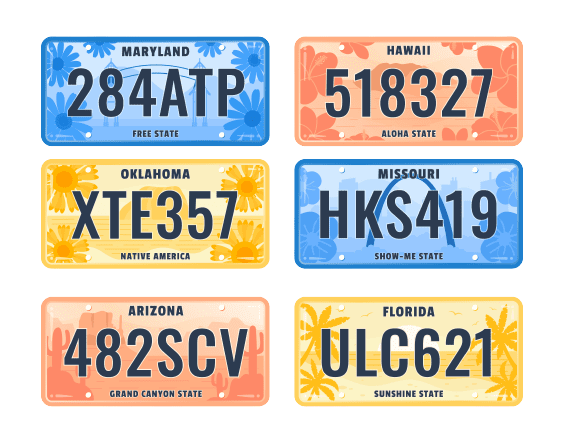
The final takeaway is, when anyone requires information regarding any vehicle, it can be easily accessed via this unique identifier. This arrangement makes the management process very easy.
Similarly, the ISSN number is a unique identifier for any serial, making the information-grabbing task easy for its consumer and administrator. In this blog, I will discuss everything about ISSN numbers in detail.
So, What is ISSN Number?
ISSN number is an abbreviation of International Standard Serial Number. It is a unique identifier or unique identification number or unique identification code given to serials such as Journals, Newspapers, Newsletters, Directories, Yearbooks, Annual Reports, Monograph series, Magazines, etc.
The ISSN number system was first drafted by the International Organization for Standardization (ISO) in 1971 and published as ISO 3297 in 1975. ISO subcommittee TC 46/SC 9 is responsible for maintaining the standard.
Throughout this blog, serial means following, which can have an ISSN number.

- Magazines,
- Newspapers,
- Annuals (such as reports, yearbooks, and directories),
- Journals,
- Memoirs,
- Proceedings,
- Transactions of societies,
- Monographic series
What is the use of the ISSN number?
- It easily identifies or easily accesses any serials of the above-discussed types.
- It also helps the publishers to keep track of each iteration of published serials. Using ISSN numbers, backtracking, and referencing tasks become very sorted and efficient.
- If you are well aware of the word “research publication“, you know about the word “citation“. Each researcher or any particular body needs referencing from other published literature in the research industry. In such a scenario, the ISSN number makes this task very easy.
- Publisher’s point of view, the ISSN number is a very important and useful thing to have for published items. Because once you acquire the ISSN number for your publication, you get international publicity and recognition free as your published item is in International Serials Directory Database.
Who assigns the ISSN number?
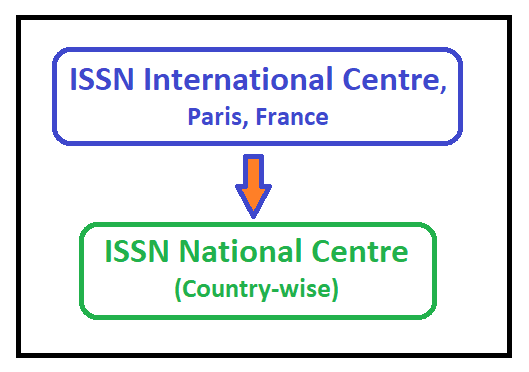
ISSN International Centre:
The overall charge of the related assignment and management activities is handled by “ISSN International Centre”, based in Paris, France. This central body is an intergovernmental organization. It was originated by UNESCO in 1974. It governs the various “ISSN National Centres” across the globe.
This entity is responsible for maintaining the database of all assigned ISSNs worldwide. This database is known as ISDS Register (International Serials Data System). Many times it is also called as ISSN Register. This register is not open accessed; however, you can opt for the subscription for access.
ISSN National Centres (89 Centres):
This body works at the country level. Usually located at the country’s national or central library. They follow the guidelines of the international centre. This is the subordinate body of the ISSN international body.
For example, an ISSN request from an Indian-origin serial will be handled by the ISSN National Centre, India (Located at India National Science Library CSIR-NIScPR, 14 Satsang Vihar Marg New Delhi – 110067 Email: issn.india@niscpr.res.in Ph.: 011- 26863759).
What is the format of ISSN?
- First, ISSN is to be written as a prefix.
- 8 digit code will follow the ISSN.
- The first 4 digits and last 4 digits are divided by “-(hyphen)”.
- Out of 8 digits, the first 7 are integer types (0-9). The last 8th digit can be from 0-9, or X. X is called the “check digit“, used for error detection and correction methods.
- We can summarize the ISSN format as follows:
- ISSN NNNN-NNNC (Where N=0-9 & C=0-9 or X means check digit)
- For Example, ISSN 2348-1269
Which are the types of ISSNs?
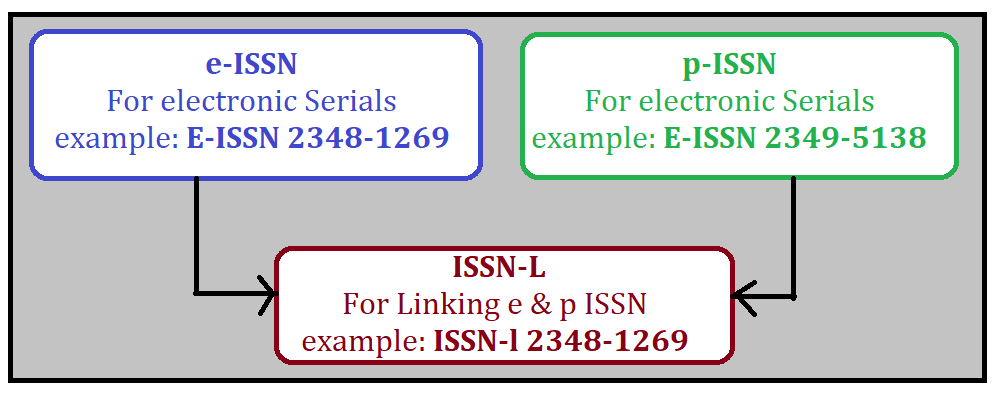
Broadly, types of ISSN are categorized as follows:
P-ISSN or p-ISSN (For Printed Version)
Used for the printed form of serial. Example: Printed magazine,
reports, journals, etc.
E-ISSN or e-ISSN (For Electronic Version)
Used for an electronic form of serial. Example: Online journals,
Online periodicals, etc.
ISSN-L or Linking ISSN (For Linking E & P ISSN)
This ISSN will link e & p ISSN. It will be the same as the ISSN of the first published form. Using this ISSN, you can easily track both forms of published medium.
Note: If the same content is published in dual format (i.e. Print and electronic), they will have different ISSNs for Print and electronic mediums. For example, the International Journal of Research and Analytical Reviews has a dual medium, so it contains two different ISSNs: (1) E-ISSN 2348-1269 (For Electronic) (2) P- ISSN 2349-5138 (For Print).
How to use ISSN for serials’ information retrival?
For this particular section, I would like to discuss 2 cases in which you can retrieve information about any serial with ISSN.
Case-1: You have ISSN but not the name of the serial.
In this case, first, visit the website https://portal.issn.org/.
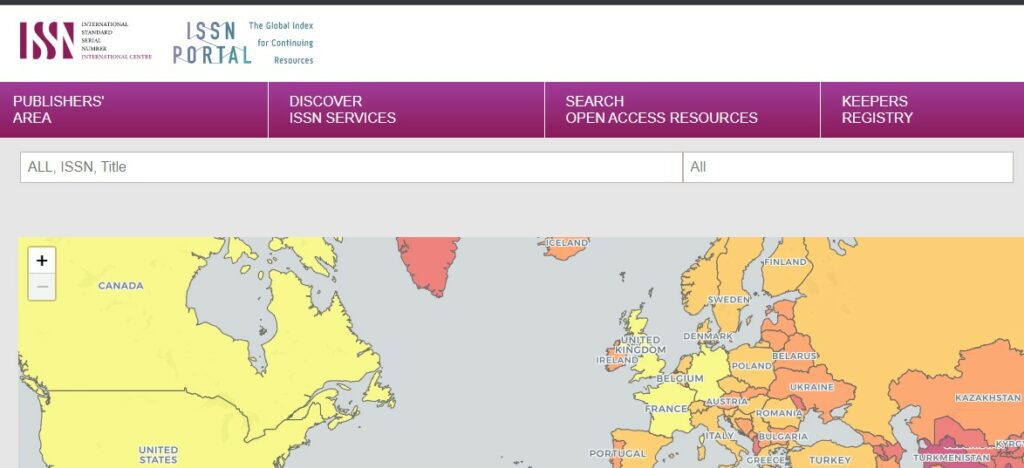
Insert ISSN only in the concern textbox and select “ISSN” from the dropdown box, as shown in the below screenshot. Then click on “Search.”
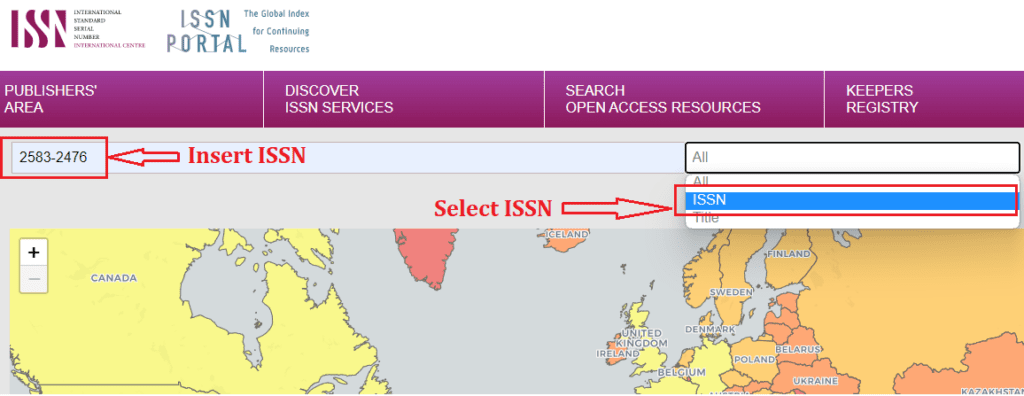
Now, you will have all the basic details about the journal or any other linked serials with inserted ISSN.
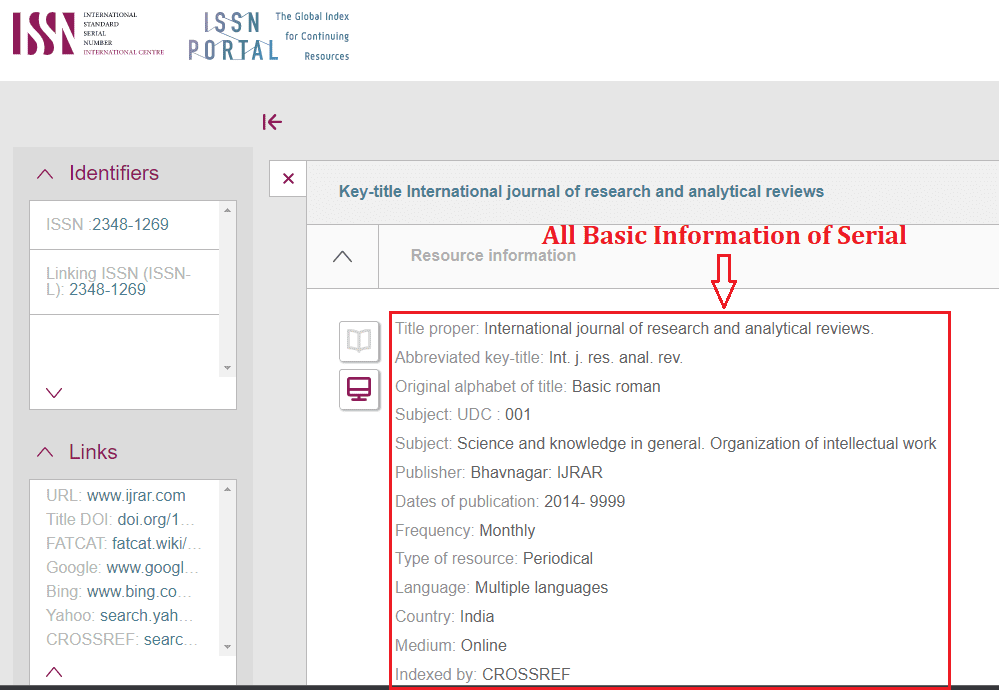
Case-2: You have the name of the serial but not the ISSN.
In this case, visit the website https://portal.issn.org/.
Insert the serial title in the concern textbox and select “title” from the dropdown box, as shown in the below screenshot. Then click on “Search.”
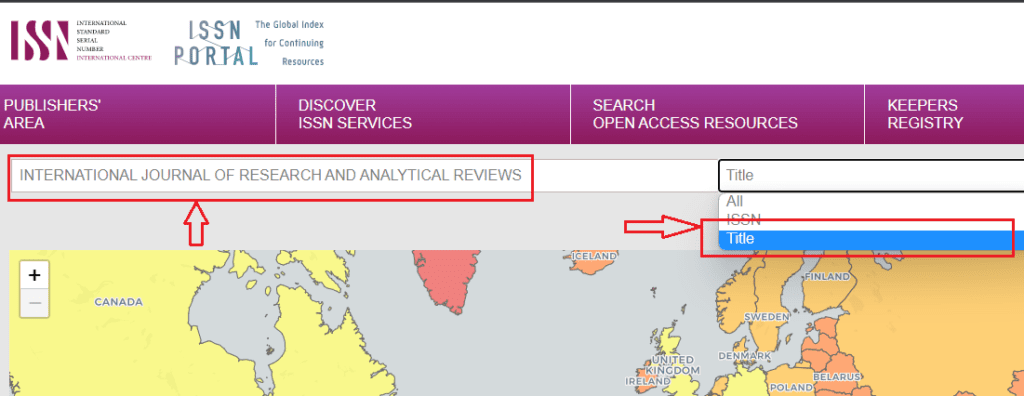
Now, you will have all the basic details about the journal if you have entered the correct title. From this process, you can retrieve the ISSN also.
Note: For retrieving the information regarding any serials, you need to have ISSN or its title. If you have the correct ISSN, then above said official portal of ISSN will eventually provide you with accurate information on the serials. By this method, you can check the authenticity of any serial.
How to get ISSN?
To get ISSN in India, visit the official website of ISSN National Centre, India, which is http://nsl.niscair.res.in/ISSNPROCESS/applyissn.jsp and follow the below steps:
Step-1
Click on the “Apply Online“.

Step-2
Check the checkbox shown below:
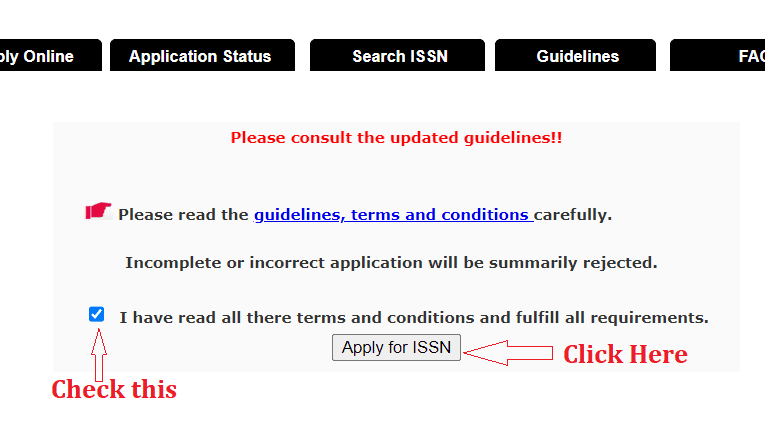
Step-3
Now, the detailed application form will be opened. Please fill relevant information.
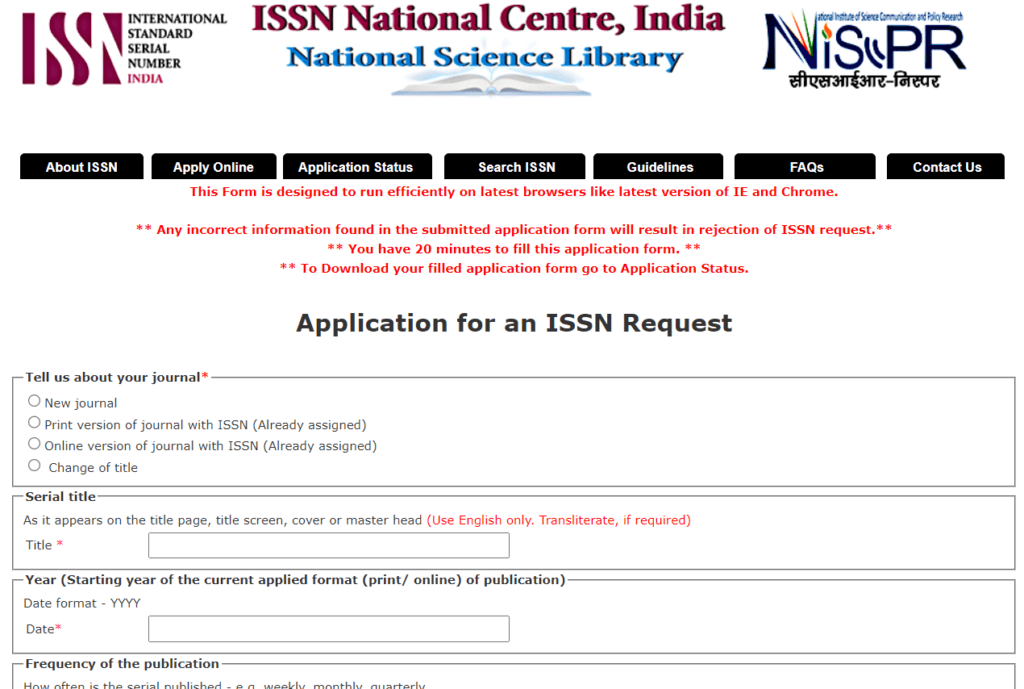
Step-4
After filling in the relevant information, check the shown check box and click on submit button.
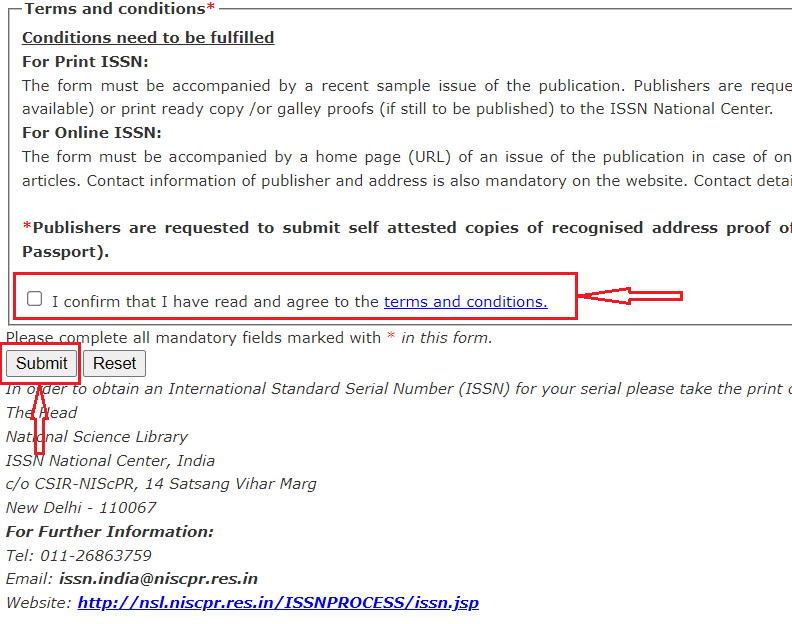
Step-5
Take the printout of the generated pdf file and sign it. Attach one self-attested photo ID proof (of publisher or applicant) along with generated pdf printout. Send these two documents in one envelope to the following address via post.
National Science Library
ISSN National Center, India
c/o CSIR-NIScPR, 14 Satsang Vihar Marg
New Delhi – 110067
For Further Information:
Tel: 011-26863759
Conclusion
All in all, ISSN is a must-have for any serials, whether in print or electronic. ISSN will automatically grab the world’s attention for the authenticity of the published serial. In addition, ISSN makes it easy for the consumer to acquire information regarding printed or electronic content. It is helpful not only for consumers but also from the administrative point of view.
For acquiring ISSN, we at OJSCloud provide tailored services for your journal’s website. Our team has a success ratio of 100% in ISSN application acceptance. We design your website in such a way that your website will get ISSN on the first Attempt. Please click below to book an appointment.
Get ISSN
